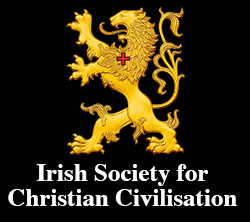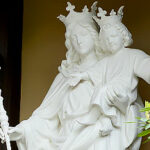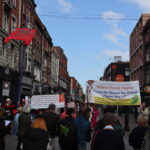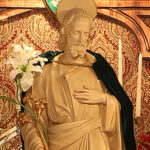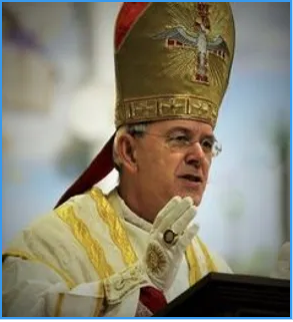
The entire world is currently aghast at the almost year long ban on public Mass in Ireland.
That ban has now been extended to include even outdoor Confessions, with Drew Harris’s Gardai now offering people the opportunity to confess their problems to them on public benches instead. Groups of 15 can now meet in public from Monday to dance and play the bongos, but if one of them is a priest, he can only sing and dance with people but not say Mass. These restrictions, their inconsistencies and the selective application of them are not merely absurd, they are evil.
Nonetheless, lay Catholics have been trying to muster opposition.
Last week, many groups gathered across the South (Mass has resumed in the North) to pray the Rosary in front of their closed churches. The campaign has gained much support and good will from across the world, with even more rosaries now set to take place this coming Sunday.
In a message of support to those involved, Bishop Athanasius Schneider has responded to an appeal from Catholic Arena. The highly esteemed Kazakhstan bishop wrote the book Dominus Est, it is the Lord: Reflections of a Bishop of Central Asia on Holy Communion, which reflected on the importance of the Eucharist, particularly at times when it had been restricted under totalitarian governments through imprisonment.
In his message of support, the bishop referred to the current Irish State suppression of public worship as ‘tyrannic’ and ‘draconian’. He expressed his support for all of those praying the Rosary outside their churches, hoping for a ‘great living Rosary chain across Ireland’.
From all my heart I support you noble campaign to get people to pray the Rosary outside their churches in the hope of a return to the Mass. May there be formed a great living rosary chain across Ireland to win the tyrannic suppression of the public Catholic worship. It is almost for everyone evident that such a draconic and systematic suppression of the Holy Mass exceeds the mere health safety. I send the blessing and my encouragement to all who participate in the Rosary campaign for a return to the Mass.
Bishop Schneider also recalled the ancestors of the Irish now unjustly denied the public celebration of their faith, stating:
In former times during the hard Penal times, the Irish Catholics left a heroic example of the loyalty to the Catholic Mass, being the Hill Mass celebrated all over Ireland clandestinely, especially on rocks, called the Mass rocks.
Bishop Schneider then continued by reflecting on the Mass’s endurance, even through centuries of repression and cruelty.
Father Augustine OFMCap wrote: “The enemies of our Faith saw now that the harassed Catholics flocked to the mud cabins as they had flocked to the churches, and bent as low before the rough altar as they had done before the work of art. It was not, therefore, anything merely human, but something really Divine that caught their eyes and gripped their souls. It was the Real Presence of Christ in the Eucharistic Sacrifice that drew the Irish people, and caused them to pour out all the wealth of their hearts in the miserable hovels which He deigned to visit even for a fleeting hour or less” (Ireland’s Loyalty to the Mass, Edinburgh 1933, p. 166). The example of love, reverence and devotion of Catholics towards Holy Mass during persecution times is a powerful lesson which may shake up our souls and kindles them with a new fire of Eucharistic love and reverence. One of the most moving and glorious historical examples is Ireland’s loyalty to the Mass in the time of persecution and the so called ‘Hidden Saints of the Mass’, described in the book of Father Augustine, OMCap., as follows: “After a tour in Ireland, the illustrious Count de Montalembert published in Paris, in the year 1829, some very interesting letters in which he describes what he had seen and felt in this country. ‘I shall never forget,’ he says, ’the first Mass which I heard in a country chapel. I rode to the foot of a hill, the lower part of which was clothed which a thick plantation of oak and fir, and alighted from my horse to ascend it. I had taken only a few steps on my way when my attention was attracted by the appearance of a man who knelt at the foot of the firs. Several others became visible in succession in the same attitude; and the higher I ascended the larger became the numbers of these kneeling peasants, At length, on reaching the top on the hill, I saw a cruciform building badly built of stone, without cement, and covered by thatch. Around it knelt a crowd of robust and vigorous men, all uncovered, though the rain fell in torrents and the mud quivered beneath them. Profound silence reigned everywhere. It was the Catholic chapel of Blarney (at Waterloo) and the priest was saying Mass. I reached the door at the moment of the Elevation, and all this pious assembly had prostrated themselves with their faces on earth. I made an effort to penetrate under the roof of the chapel thus overflowed by worshippers. There were no seats, no decorations, not even a pavement; the floor was of earth, damp and stony, the roof dilapidated, and tallow candles burned on the altar in place of tapers. When the Holy Sacrifice was ended, the priest mounted his horse and rode sway. Then each worshipper rose from his knees and went slowly homeward. Many remained for a much longer time in prayer, kneeling in the mud in that silent enclosure chosen by the poor and faithful people in the time of ancient persecutions’.” (Ireland’s loyalty to the Mass, op. cit., 194-197).
It is a source of immense encouragement for those actively resistant Irish Catholics to hear of support from a bishop, especially from one who so clearly understands the Real Presence of the Blessed Sacrament and the fortitude needed to withstand attacks that occur against our relationship to the Holy Sacrifice of the Mass.
When Irish Catholics gather this Sunday to pray the Rosary outside their churches, may this encouragement and blessing assist them in their cause.
This year, it is more crucial than ever that we turn to prayer and intercession to increase devotion to Our Lady across our country. That’s why you’re invited to join us in the Three Hail Marys Pledge, a powerful devotion that can bring personal spiritual benefits and national transformation. By reciting three Hail Marys daily, you honour the Immaculate Heart of Mary and seek her intercession for the conversion of sinners, the salvation of souls and the restoration of Ireland’s Catholic Faith. This ancient devotion, revealed to Saint Mechtilde, promises spiritual benefits including protection from mortal sin and the assurance of a good death. Your daily prayers will contribute to an increase in devotion to Our Lady, the conversion of sinners and the moral renewal of our country. Let us commit to this powerful devotion and seek the guidance and protection of Our Lady.


